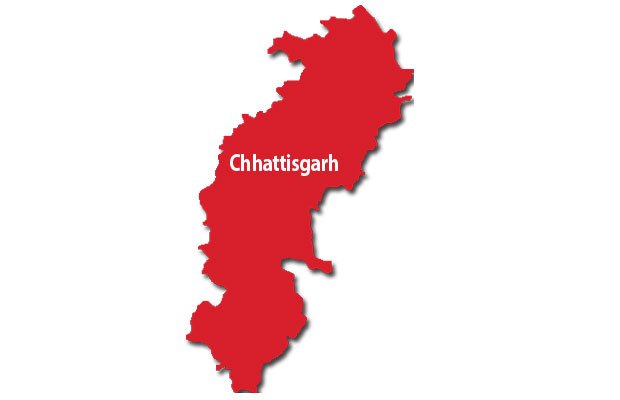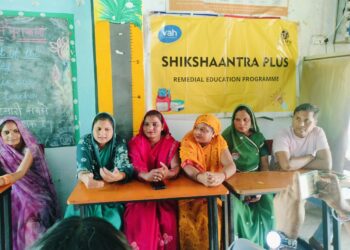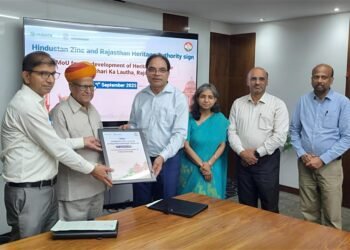National Skill Development Corporation (NSDC) had mandated Deloitte Touche Tohmatsu India Private Limited (DTTIPL) to undertake a District-level Skill Gap Study for the state of Chhattisgarh. The study focused on identifying the district level manpower requirement across skill levels and sectors over the period 2012-22.
The methodology adopted for undertaking the study involved extensive desk research and primary interactions with various departments of the Government of Chhattisgarh, industries, industry associations, government and private vocational skill training providers and educational institutions.
Focus group discussions and youth surveys were organized to understand youth aspirations towards skill development and employment. Based on the findings of the analysis and interactions, recommendation for skill development initiatives in the state have been proposed for key stakeholders.
Also Read: Like Assam, Jashpur of Chhattisgarh also has lush tea gardens: Bhupesh Baghel, CG Chief Minister
Socio Economic Profile of Chhattisgarh
The state of Chhattisgarh was formed on 1st November 2000 by carving out the 16 Chhattisgarhi speaking south-eastern districts of Madhya Pradesh. It covers an area of about 135,190 sq. km. which is 4.1% of the country’s area. Chhattisgarh is a land locked state comprising of 27 districts, which is further divided into 149 blocks and 9734 gram panchayats.
As per census 2011, Chhattisgarh has a total population of 2.56 crores amounting to 2.1% of India’s population and ranks 16th amongst all the states in India in terms of population. The state exhibited a high decadal population growth rate (22.61%) as compared to the national average (17.6%) and ranked 6th in terms of decadal population growth rate over the period 2001-11.
The state also has a high tribal (30.6%) population. Bastar, Dantewada, Koriya and Korba are the chief tribal dominant districts in the state. The sex ratio of Chhattisgarh (991) is greater than the national average (943).
The literacy rate in Chhattisgarh has improved significantly from 64.7% in 2001 to 70.3% in 2011 and is slightly less than the national average of 73.0%. Both male (80.27%) and female (60.24%) literacy rates registered good improvement over the decade. Chhattisgarh has a total of 58,230 schools with a total enrolment of 57.50 lakh students in the year 2011-121.
Elementary education in the state has improved considerably largely due to the impact of the Sarva Shiksha Abhiyan. The Gross Enrolment Ratio (GER) in the state at primary level for 2010-11 was registered as high as 125% while at upper primary level it was 95.7%2. The state also has a total of 180 ITI’s & private ITI’s, of which, 129 are Government Industrial Training Institutes and 51 private Industrial Training Institute3. In terms of higher education infrastructure, the state has a total of 15 universities, of which 12 universities are State level Universities
(8 public & 4 private), 1 Central University, 1 University of national importance and 1 State Open University. With a share of 2.4% of the total Universities in the country, Chhattisgarh ranks 18 amongst all the states of India. The state ranks 7th in the country in terms of the total number of State private universities. Chhattisgarh has a share of 1.7% of all colleges in India and ranks 15th in terms of total colleges among the Indian states.
The economy of Chhattisgarh has registered a CAGR of about 8.5% (estimated at constant prices, 2004-05) between 2004-05 and 2012-13 and almost doubled from Rs. 47, 862 cr. to Rs 91,933 cr (Source: CSO). The Services sector has shown the highest growth rate in the state over the period 2005-2013 with a CAGR of 10.7% followed by Industry and Agriculture sectors which registered a CAGR of 7.4% and 6.8% respectively.
Also Read: Vedanta Skill Schools in Chhattisgarh train nearly 600 youth in FY22
The economy of Chhattisgarh is pre-dominantly Industry sector based, with Industries’ share in GSDP being highest (40.9%) in 2012-13 followed closely by Services sector. in 2012-13. In 2012-13, registered manufacturing comprised 34% of contribution by Industry sector followed by construction (24%), mining & quarrying (24%), electricity, gas & water supply (14%) and unregistered manufacturing (5%).
It is important to note that the increase in Services sector (from 34.4% to 40.3%) is primarily due sectors such as Transport, Storage and Communication and BFSI. The contribution of Agriculture sector in the state economy is relatively on the decline.
District-wise comparison of economic contribution in 2008-09 indicates that the districts of Durg, Raipur, Korba, Raigarh and Bilaspur* are the top 5 districts in terms of contribution to the Gross State Domestic Product. It is to be noted that these 5 districts are also one amongst the most populous districts of Chhattisgarh.
The state per capita income (estimated at 2004-05 constant prices) has increased from Rs. 24,690 in 2009-10 to Rs. 29,635 in 2011-12 registering 20% increase over the period 2009-12; however it is still lower than the national average of Rs. 38,005 during 2011-12 by around 22%5.
In terms of employment, Chhattisgarh State had a share of 1.16% in all India employment as on 31st March, 20116. Out of the total population of 2.56 cr., the working age population (between 15-59 age group) constitutes 1.53 cr. or nearly 60%7. Based on the labour force participation rate and the worker participation rate8, the workers/ workforce in 2011 among the working age population are estimated at 1.08 cr. or nearly 70% of the working age population.
Agriculture sector is the highest employer in Chhattisgarh with about 72.9% of the total workforce engaged in the sector in 2012. The sector however only contributes around 19% to the Gross State Domestic Product (GSDP). The Industry sector which has the highest contribution in GSDP in 2012 at approximately 42% employs around 11% of the total workforce.
The Services sector has a share of around 39% in the state economic activity employing approximately 15% of the total workforce in Chhattisgarh in 2012. As per the analysis of sub-sectoral employment, Agriculture is the key employment provider in state employing around 73% of the working age population in the state followed by Manufacturing sector (7.5%), Trade, Hotels & Restaurants (6.5%), Other services (3.7%) & Construction (2.4%).
The top 5 sectors in Chhattisgarh account for around 93% of the total employment of workforce in state in 2012.
Skill Gap Assessment
The current demographic and economic profile of Chhattisgarh presents significant opportunity for manpower skilling. As per the methodology adopted, the estimated incremental human resource demand in the period 2012-22 will be about 30.44 lakhs, with 33% expected in semi-skilled segment.
Sectors like agriculture, manufacturing (primarily mineral/ metal based), building & construction and mining & quarrying are expected to contribute around two third of this demand (64.7%). Due to relatively higher anticipated growth rates, Banking, Financial Services & Insurance (BFSI) segments and Communication are the growth sectors which are also expected to contribute to the incremental demand.
Also Read: CSR: NTPC Lara launches Girl Empowerment Mission (GEM) in Chhattisgarh
Youth aspirations suggest a preference to work in sectors like Construction, Manufacturing, BFSI etc. District level incremental manpower requirements estimation indicates that the districts of Raipur, Durg, Bilaspur, Korba & Raigarh account for around 47% of the manpower requirement, with most incremental demand expected to be generated in the sectors such as Agriculture, manufacturing (primarily mineral/ metal based), Building & Construction, Mining & Quarrying and Trade (wholesale + Retail).
In terms of manpower supply, the estimated incremental supply over the same period is around 34.27 lakh. The proportion of incremental supply of minimally skilled manpower is 55%, compared to 27% of semi-skilled and 18% of skilled manpower (2012-22).
During the period 2012-22, the incremental demand supply gap of the state is expected to be a surplus of about 3.83 lakhs i.e. the state will have excess of incremental manpower supply. While a shortage of manpower is likely to be expected across semi-skilled (0.72 lakhs) segment, an excess supply is estimated in the skilled (1.34 lakhs) and minimally skilled (3.21 lakhs) segments.
This implies that the excess supply of minimally skilled labour force can be facilitated to shift to productive employment capacity assumed at the semi-skilled level by improving the education & training infrastructure as well as skill development initiatives in the state.
Also, the rate of creation of employment generation in the state has to be boosted with suitable government and private initiatives in order to absorb the surplus supply of labour force anticipated to enter job market over the decade. In order to ensure maximum and optimum utilization of surplus supply of human resources, government may also aim at developing entrepreneurial qualities amongst youngsters and prepare new entrepreneurs to setup their own small enterprises.
Youth Aspirations
Youth population constitutes the most important demographic section of society from a skill development perspective. In light of changing manpower requirements of the industry, it is important to understand the aspirations of youth with regard to education, career preference, job location etc. to design suitable initiatives. This was done through interactions with around 2000 youth across the state.
Majority of the youth surveyed in the state prefer Government/ public sector jobs over private jobs due to the job security, employee friendly policies, pensions and other benefits offered in such jobs.
Also Read: Chhattisgarh to focus more on improving students’ learning ability in govt schools
Most of the students prefer to be employed in established and renowned organizations like CSEB, SAIL, NTPC, SECL, BALCO etc. as it offers them better job profile, salary, job security and employer friendly environment. Moreover, majority of the youth (esp. rural youth and women) prefer jobs within the district. Though men are willing to take up jobs outside the district on account of better employment opportunities, women preferred to work within the district.
In terms of preference of trade, training for job readiness appears to be the most popular amongst the youth in the state. Apart from the regular courses offered by the educational/ training institutions; bridge courses like spoken English, basic Communication Skills, Personality Development, Soft Skills & basic IT skills are considered to be very important by youth which they feel is one of the most important element to get a job.
Given the criticality of computer operation knowledge, Computer related courses like COPA (Computer Operator and Programming Assistant), BCA (Bachelor of Computer Application), DCA (Diploma in Computer Application) & PGDCA (Post Graduate Diploma in Computer Application) are also the popular courses amongst the youth.
While selecting an institute of higher education, the institutions are selected by the youth on the basis of employment opportunities available post training, quality of education offered, institute’s infrastructure, proximity to home, availability of seats/ subject of interest and financial considerations.
Youth aspirations in the state suggest that vocational training is perceived to be less desirable compared to professional/technical education due to social norms and limited awareness.
It was also learnt that youth are not fully aware about the newly introduced Govt. initiatives on skill development such as VTPs (MES/ SDI scheme), NSDC training partners and Star Scheme. The key points highlighted by the youth during the perception mapping exercise are as follows:
- Low satisfaction with placement / jobs available post training with around 57% of the students surveyed expressing their dissatisfaction with the placement opportunity.
- Non-availability of latest technologies and equipment for training in institutes with around 55% of the students surveyed expressing their dissatisfaction with the same.
- Low satisfaction with capability of institute’s faculty in teaching with around 64% of the youth surveyed (especially the students from Government colleges) expressing their dissatisfaction.
- Need for better access to information to make an informed career choice with around 62% of students surveyed expressing their dissatisfaction with access to information to make informed career choice.
- Access to institutes is an issue in rural areas highlighted by around 67% students surveyed.
- Dissatisfaction with the alignment of training/education received with job requirements with approximately 69% of the youth surveyed advocating that the training/education currently provided by educational institutes in district is not in alignment with the job requirements of business.
Key Challenges and recommendations
The table below provides a snapshot summarizing key issues & corresponding recommendations suggested for each stakeholder. It is important that all stakeholders work in close collaboration with each other, in consultative manner, to achieve the objectives outlined by the State for improving skill development scenario in Chhattisgarh.
District level skill gaps & detailed recommendations are provided in the full report. It is also suggested that an appropriate agency be designated as the nodal agency to co-ordinate the implementation of recommendations, as required.
(India CSR)





















